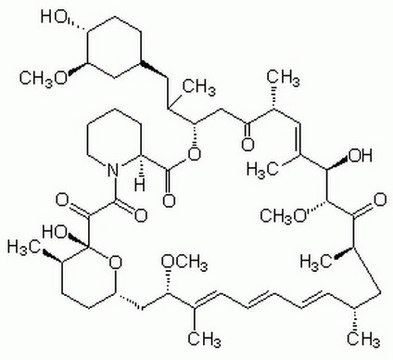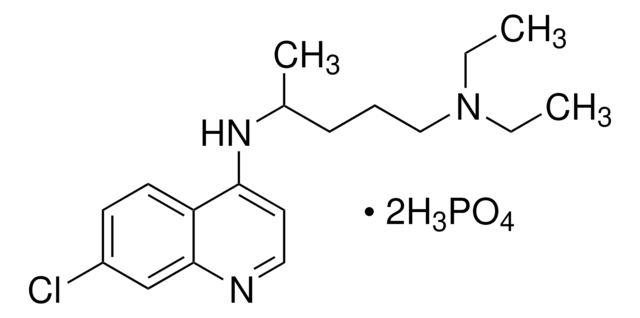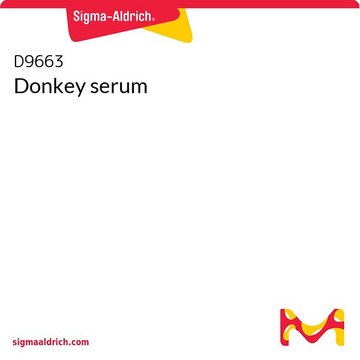15-105
mTOR phosphorylation Pathway Explorer Antibody MiniPack
This Antibody pack of Anti-mTOR antibodies contains Anti-phospho-mTOR Antibody(Ser2481), Anti-phospho-mTOR Antibody (Thr2446), Anti-phospho-mTOR (Ser2448).
别名:
FKBP12-rapamycin complex-associated protein 1, FKBP-rapamycin associated protein, Mammalian target of rapamycin, Rapamycin target protein, rapamycin associated protein FRAP2
登录查看公司和协议定价
所有图片(6)
About This Item
UNSPSC代码:
12161503
eCl@ss:
32161000
NACRES:
NA.77
推荐产品
生物来源
rabbit
质量水平
抗体形式
affinity isolated antibody
纯化方式
affinity chromatography
制造商/商品名称
Upstate®
技术
activity assay: suitable
NCBI登记号
UniProt登记号
运输
dry ice
基因信息
human ... MTOR(2475)
一般描述
Pathway Explorer Antibody MiniPack:
Each Pathway Explorer Antibody Minipack contains three related antibodies as part of a signaling cascade or a combination of total and phosphorylated forms of key signaling targets. Each of the three antibodies are 30% the original pack size. Full size versions of each of the Pathway Explorer antibodies are available for sale individually under the same catalog number with the removal of “SP” off of each one (e.g. 05-591SP can be ordered as 05-591).
mTOR:
mTOR (Mammalian Target of Rapamycin, aka FRAP, RAPT or RAFT) is a large 289 kDa Ser/Thr protein kinase that regulates cell cycle progression, cell growth, protein synthesis, ribosome biogenesis, and autophagy. mTOR is an evolutionarily conserved member of the Phosphoinositol Kinase-related Kinase (PIKK) family whose activity is regulated by phosphorylation on Ser2448 by Akt in response to insulin or muscle activity. Interestingly, mTOR is the central component of two multimeric kinase complexes consisting of mTOR and numerous other mTOR binding proteins. These two multimeric protein complexes are designated mTORC1 and mTORC2. mTORC1 (mTOR Complex 1) consists of at least mTOR, Raptor, and GβL (mLST8). mTORC1 is known to play a central role in insulin signaling, which is crucial in maintaining metabolic homeostasis. The complex is activated primarily though the PI3 Kinase/Akt pathway. Upon insulin stimulation, Akt activates mTORC1 by phosphorylating and inhibiting TSC (and possibly other yet discovered targets and/or mTOR itself). This inhibits the upstream small GTPase regulator Rheb (Ras homolog enriched in brain). This inhibits the kinase activity of the mTORC1 complex, thus disabling its ability to phosphorylate its downstream targets such as p70 S6K on Thr389 and 4E-BP1 on Thr229. The other mTOR complex, mTORC2 (mTOR Complex 2), is made up of at least mTOR, Rictor, GL, Sin1, Protor 1 and 2. mTORC2 affects cell proliferation and survival primarily by phosphorylating the hydrophobic motif of Akt on Ser473, a well-known effecter of the PI3 Kinase pathway. In addition to phosphorylating Akt, the mTORC2 complex is also known to effect cytoskeletal organization and migration by exerting its effects through Rac, Rho, and PKC. Interestingly, unlike mTORC1, the mTORC2 complex appears to not be inhibited by treatment with rapamycin and for this reason is referred to as the rapamycin-insensitive complex. Defects in both mTOR complexes are associated with a variety of diseases, including cancer and diabetes.
*See full size versions for corresponding references.
Each Pathway Explorer Antibody Minipack contains three related antibodies as part of a signaling cascade or a combination of total and phosphorylated forms of key signaling targets. Each of the three antibodies are 30% the original pack size. Full size versions of each of the Pathway Explorer antibodies are available for sale individually under the same catalog number with the removal of “SP” off of each one (e.g. 05-591SP can be ordered as 05-591).
mTOR:
mTOR (Mammalian Target of Rapamycin, aka FRAP, RAPT or RAFT) is a large 289 kDa Ser/Thr protein kinase that regulates cell cycle progression, cell growth, protein synthesis, ribosome biogenesis, and autophagy. mTOR is an evolutionarily conserved member of the Phosphoinositol Kinase-related Kinase (PIKK) family whose activity is regulated by phosphorylation on Ser2448 by Akt in response to insulin or muscle activity. Interestingly, mTOR is the central component of two multimeric kinase complexes consisting of mTOR and numerous other mTOR binding proteins. These two multimeric protein complexes are designated mTORC1 and mTORC2. mTORC1 (mTOR Complex 1) consists of at least mTOR, Raptor, and GβL (mLST8). mTORC1 is known to play a central role in insulin signaling, which is crucial in maintaining metabolic homeostasis. The complex is activated primarily though the PI3 Kinase/Akt pathway. Upon insulin stimulation, Akt activates mTORC1 by phosphorylating and inhibiting TSC (and possibly other yet discovered targets and/or mTOR itself). This inhibits the upstream small GTPase regulator Rheb (Ras homolog enriched in brain). This inhibits the kinase activity of the mTORC1 complex, thus disabling its ability to phosphorylate its downstream targets such as p70 S6K on Thr389 and 4E-BP1 on Thr229. The other mTOR complex, mTORC2 (mTOR Complex 2), is made up of at least mTOR, Rictor, GL, Sin1, Protor 1 and 2. mTORC2 affects cell proliferation and survival primarily by phosphorylating the hydrophobic motif of Akt on Ser473, a well-known effecter of the PI3 Kinase pathway. In addition to phosphorylating Akt, the mTORC2 complex is also known to effect cytoskeletal organization and migration by exerting its effects through Rac, Rho, and PKC. Interestingly, unlike mTORC1, the mTORC2 complex appears to not be inhibited by treatment with rapamycin and for this reason is referred to as the rapamycin-insensitive complex. Defects in both mTOR complexes are associated with a variety of diseases, including cancer and diabetes.
*See full size versions for corresponding references.
免疫原
Epitope: 09-345SP:phosphorylated Thr2446 of mTOR
09-213SP: phosphorylated Ser2448 of mTOR
09-343SP: phosphorylated Ser2481 of mTOR
09-213SP: phosphorylated Ser2448 of mTOR
09-343SP: phosphorylated Ser2481 of mTOR
应用
Pathway Explorer Antibody MiniPack
Research Category
Signaling
Apoptosis & Cancer
Signaling
Apoptosis & Cancer
Research Sub Category
PI3K, Akt, & mTOR Signaling
Glucose/Glycogen Metabolism
Insulin/Energy Signaling
PI3K, Akt, & mTOR Signaling
Glucose/Glycogen Metabolism
Insulin/Energy Signaling
This Antibody pack of Anti-mTOR antibodies contains Anti-phospho-mTOR Antibody(Ser2481), Anti-phospho-mTOR Antibody (Thr2446), Anti-phospho-mTOR (Ser2448).
包装
Each vial is 30% the size of the parent catalog number
组分
09-343SP Anti-phospho-mTOR (Ser2481); 30 µL
09-345SP Anti-phospho-mTOR (Thr2446); 30 µL
09-213SP Anti-phospho-mTOR (Ser2448); 60 µL
09-345SP Anti-phospho-mTOR (Thr2446); 30 µL
09-213SP Anti-phospho-mTOR (Ser2448); 60 µL
外形
3 individual tubes each containing antibodies directed against one of the three phosphorylated forms of mTOR (Thr2446, Ser2448, and Ser2481)
法律信息
UPSTATE is a registered trademark of Merck KGaA, Darmstadt, Germany
免责声明
Unless otherwise stated in our catalog or other company documentation accompanying the product(s), our products are intended for research use only and are not to be used for any other purpose, which includes but is not limited to, unauthorized commercial uses, in vitro diagnostic uses, ex vivo or in vivo therapeutic uses or any type of consumption or application to humans or animals.
储存分类代码
10 - Combustible liquids
法规信息
新产品
C L van der Wijden et al.
Nutrition & diabetes, 3, e86-e86 (2013-09-11)
From a public health perspective it is important to know which of the currently used methods to estimate changes in maternal body fat during pregnancy and the year thereafter is the most adequate. To evaluate the concurrent validity between leptin
Arkadiusz D Liśkiewicz et al.
Frontiers in endocrinology, 12, 568197-568197 (2021-03-16)
Obesity cardiomyopathy increases the risk of heart failure and death. Obesity is curable, leading to the restoration of the heart phenotype, but it is not clear if there are any after-effects of obesity present after weight loss. We characterize the
Francesca Bianchini et al.
The British journal of nutrition, 108(12), 2129-2137 (2012-03-07)
Prostate cancer is one of the most common malignancies in men. Epidemiological and experimental studies have revealed that stromal cells of the tumour microenvironment contribute to the development of prostate cancers, while long-chain n-3 PUFA-enriched diets reduce the risk of
Fatemeh Talaei et al.
BMC cell biology, 15, 1-1 (2014-01-08)
Diabetes and particularly high blood glucose levels are implicated in neurodegeneration. One of the hallmarks of neurodegeneration is protein aggregation. We investigated the presence of protein aggregation in the frontal brain of Zucker diabetic fatty (ZDF) rats, an animal model
我们的科学家团队拥有各种研究领域经验,包括生命科学、材料科学、化学合成、色谱、分析及许多其他领域.
联系技术服务部门








